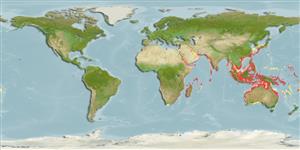Common names from other countries
>
Ovalentaria/misc (Various families in series Ovalentaria) >
Ambassidae (Asiatic glassfishes)
Etymology: Ambassis: Derived from Greek, anabasis = climbing up (Ref. 45335).
More on author: Lacepède.
Environment: milieu / climate zone / depth range / distribution range
Ökologie
seewasser; süßwasser; brackwasser demersal; pH range: 7.2 - 8.2; amphidrom (Ref. 51243). Tropical; 22°C - 28°C (Ref. 12468)
Indo-West Pacific: South and East Africa, including Mauritius, Réunion, Madagascar and Seychelles, to Philippines, north to India, south to northern Australia (Ref. 33390). Extends south on African coast at least to Algoa Bay, South Africa (Ref. 4318).
Size / Gewicht / Alter
Maturity: Lm ? range ? - ? cm
Max length : 16.0 cm TL Männchen/unbestimmt; (Ref. 4180)
Rückenflossenstacheln (insgesamt): 7 - 8; Rückenflossenweichstrahlen (insgesamt): 8-10; Afterflossenstacheln 3; Afterflossenweichstrahlen: 8 - 10.
Fairly common in marine and fresh waters (Ref. 4180); found in shallow waters; common in estuaries; may enter lower reaches of rivers. Can tolerate fresh water only within a narrow temperature (23-26°C). Feeds mainly at night on crustaceans, but also takes small fishes, fish eggs and larvae in estuaries (Ref. 7248). Marketed dried, salted and fresh (Ref.97399).
Life cycle and mating behavior
Geschlechtsreife | Fortpflanzung | Ablaichen | Eier | Fecundity | Larven
Maugé, L.A., 1986. Ambassidae. p. 297-298. In J. Daget, J.-P. Gosse and D.F.E. Thys van den Audenaerde (eds.) Check-list of the freshwater fishes of Africa (CLOFFA). ISNB, Brussels; MRAC, Tervuren; and ORSTOM, Paris. Vol. 2. (Ref. 4180)
IUCN Rote Liste Status (Ref. 130435)
CITES (Ref. 128078)
Not Evaluated
Bedrohung für Menschen
Harmless
Nutzung durch Menschen
Fischereien: weniger kommerziell; Köder: occasionally
Mehr Information
NamenSynonymeMetabolismusRäuberÖkotoxikologieFortpflanzungGeschlechtsreifeAblaichenFecundityEierEientwicklung
ReferenzenAquakulturAquakultur ProfilZuchtlinienGenetikElectrophoresesVererbbarkeitKrankheitenVerarbeitungMass conversion
PartnerBilderStamps, Coins Misc.LauteCiguateraGeschwindigkeitSchwimmstilKiemenoberflächeOtolithsGehirngrößeSehfähigkeit
Tools
Zusatzinformationen
Download XML
Internet Quellen
Estimates based on models
Preferred temperature (Ref.
115969): 24.2 - 29.1, mean 28.1 (based on 1254 cells).
Phylogenetic diversity index (Ref.
82804): PD
50 = 0.5000 [Uniqueness, from 0.5 = low to 2.0 = high].
Bayesian length-weight: a=0.01318 (0.00743 - 0.02338), b=3.01 (2.86 - 3.16), in cm Total Length, based on LWR estimates for this species & Genus-body shape (Ref.
93245).
Trophic level (Ref.
69278): 3.9 ±0.56 se; based on food items.
Widerstandsfähigkeit (Ref.
120179): hoch, Verdopplung der Population dauert weniger als 15 Monate. (k=1.20).
Fishing Vulnerability (Ref.
59153): Low vulnerability (12 of 100).
